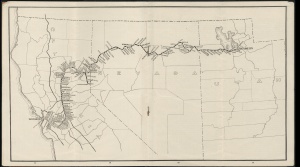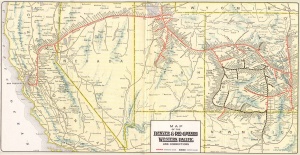Reynard: Difference between revisions
Reynard |
Added The Train Sheet citation about the origin. |
||
| (8 intermediate revisions by the same user not shown) | |||
| Line 1: | Line 1: | ||
Reynard is a [[Railroad | railroad]] siding between [[Sano]] and [[Bronte]] | Reynard is a [[Railroad | railroad]] siding between [[Sano]] and [[Bronte]]. South of Reynard is the site of [[Smoke Creek Station]]<ref>Helen S. Carlson, "[http://books.google.com/books?id=BixwbIM7ZvAC&lpg=PA219&dq=Reynard%20Nevada&pg=PA219#v=onepage&q=Reynard%20Nevada&f=falseNevada Place Names: A Geographical Dictionary]," p. 219</ref>. | ||
Wikipedia states "Reynard is a literary cycle of allegorical French, Dutch, English, and German fables largely concerned with Reynard, an anthropomorphic red fox and trickster figure"<ref>"[https://en.wikipedia.org/wiki/Reynard Reynard]," Wikipedia, accessed 27-Nov-2014</ref>. Probably Reynard and the nearby [[Fox Range]] share a common origin. "The Train Sheet" states that Reynard is the namr of the fox in "Reynard the Fox" and that foxes were common in the area.<ref>Vic Neves, "[https://www.wplives.org/train_sheet_archive/pdf/ts042.pdf What's in a name? Romance Among the ties of the W. P.", The Train Sheet]," March/April 1990, number 42.</ref> | |||
Myrick states that prior to 1917, the Western Pacific was considering building a light-traffic line from Reynard through [[Buffalo Canyon]] to the [[Surprise Valley]] near [[Cedarville]]<ref>David F. Myrick, "[http://books.google.com/books?id=G7NNMH9X4w8C&lpg=PA331&dq=Reynard%20Nevada&pg=PA331#v=onepage&q=Reynard%20Nevada&f=false Railroads of Nevada and Eastern California: The northern roads]," p. 331</ref>. | |||
In 1921, the Nevada State Legislature granted a right of way to John E. Sexton and associates that ran from Reynard northwest to T 37N R 18 E, which is near [[Duck Lake]] and the California line. During the first 10 years, operating the line was optional during January, February and March.<ref>Senator Cowles"[http://books.google.com/books?id=dAyxAAAAIAAJ&dq=Reynard%20Nevada&pg=PA359#v=onepage&q=Reynard&f=false Statutes of the State of Nevada]," Nevada Senate Bill 109, March 28, 1921</ref> | |||
[[Image:Cscrm_000335_07_access3675x2040.jpg|right|thumb|WPRR 1910 Timetable showing Reynard]] | |||
[[Image:1930_D&RGW_WP.jpg|right|thumb|c. 1914 map of the W.P.R.R. showing Reynard]] | [[Image:1930_D&RGW_WP.jpg|right|thumb|c. 1914 map of the W.P.R.R. showing Reynard]] | ||
== References == | |||
<references/> | |||
[[Category:Railroad sidings]] | |||
[[Category:Smoke Creek Desert]] | |||
Latest revision as of 03:48, 22 October 2020
Reynard is a railroad siding between Sano and Bronte. South of Reynard is the site of Smoke Creek Station[1].
Wikipedia states "Reynard is a literary cycle of allegorical French, Dutch, English, and German fables largely concerned with Reynard, an anthropomorphic red fox and trickster figure"[2]. Probably Reynard and the nearby Fox Range share a common origin. "The Train Sheet" states that Reynard is the namr of the fox in "Reynard the Fox" and that foxes were common in the area.[3]
Myrick states that prior to 1917, the Western Pacific was considering building a light-traffic line from Reynard through Buffalo Canyon to the Surprise Valley near Cedarville[4].
In 1921, the Nevada State Legislature granted a right of way to John E. Sexton and associates that ran from Reynard northwest to T 37N R 18 E, which is near Duck Lake and the California line. During the first 10 years, operating the line was optional during January, February and March.[5]


References
- ↑ Helen S. Carlson, "Place Names: A Geographical Dictionary," p. 219
- ↑ "Reynard," Wikipedia, accessed 27-Nov-2014
- ↑ Vic Neves, "What's in a name? Romance Among the ties of the W. P.", The Train Sheet," March/April 1990, number 42.
- ↑ David F. Myrick, "Railroads of Nevada and Eastern California: The northern roads," p. 331
- ↑ Senator Cowles"Statutes of the State of Nevada," Nevada Senate Bill 109, March 28, 1921